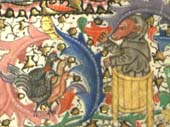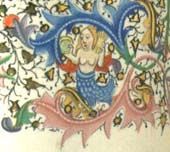Marginalia
At the Limits of Society and the Page
Delicate sylvan decoration, hybrid beasts, and depraved humans engaging in irreverent acts seem counterintuitive to surround the pious content of a Book of Hours, yet between the mid-twelfth and fifteenth centuries, the margins of all types of medieval manuscripts were filled with ornate and curious imagery. How the medieval illuminator and reader understood and reacted to these images is unknown, though many hotly contested theories abound. Initially dismissed by scholars as purely decorative or simply the daydreams of an imaginative illustrator, marginalia is now interpreted by some as exemplifying how the sacred was defined in opposition to the profane within the rigidly hierarchical organization of the medieval world.
Flora - and Fauna
Marginalia also reflect the beginnings of naturalism in western art. Intricate renderings of natural imagery in the margins were an excellent means for illustrators to demonstrate their skill. Images of apes in wicked revelry are common in marginal art (and are shown here within the Chew Breviary), and may have been a powerful reminder of the potential within all medieval men and women to engage in depraved acts. Apes were described in the
Bestiary (a medieval collection of beliefs about the attributes of animals) as “disgraceful” and having “hideous countenances,” and were felt to be unnervingly similar to humans in their reason and actions
Hybrids, Chimeras, and Beasts
Chimeric beasts, autophagic dragons, and ornate floral motifs threatened to distract the reader during pious contemplation of the text. Especially noteworthy on this page from the Lawrence Hours are the jester in the top right corner and the fox in monk’s clothing preaching to a flock of birds at lower right. The fox-monk image illustrates a common folktale in which Reynard the Fox disguises himself in clerical clothing and tricks gullible fowl, highlighting the common belief that foxes were fraudulent and ingenious creatures, with a nature much like the Devil – and incidentally commenting on the moral character of the clergy.
Outcast to the edge
While modern observers may label half-human hybrids as mythical, the medieval viewer might have assumed that these beings actually existed at the far corners of the earth: impure places inhabited by all sorts of evil-doers. This image of a mermaid holding a comb and a mirror is intriguing, as it alludes to femininity, temptation, and sin. Such marginal representations of the liminal are not restricted to non-human figures. In both the Lawrence Hours and the Chew Breviary, for example, conical hats on people in the margins mark the wearers as Jews, whose presence in the periphery reflects the marginalization of the Jewish faith within medieval Christian art and society.




